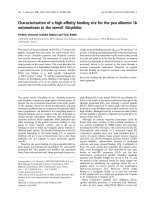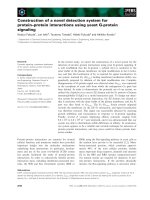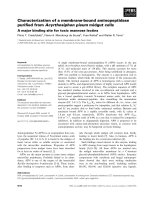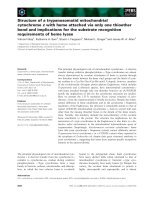Báo cáo "Algorithm for solution of a routing problem " pot
Bạn đang xem bản rút gọn của tài liệu. Xem và tải ngay bản đầy đủ của tài liệu tại đây (104.94 KB, 5 trang )
VNU Journal of Science, Mathematics - Physics 23 (2007) 178-182
178
Algorithm for solution of a routing problem
Tran Vu Thieu
*
, Pham Xuan Hinh
Institute of Mathematics, 18 Hoang Quoc Viet, Cau Giay, Hanoi, Vietnam
Received 15 November 2006; received in revised form 12 September 2007
Abstract. In this paper we consider a combinatorial optimization problem that is similar to the
bottleneck traveling salesman problem. We show that an optimal tour for this problem is
pyramidal tour (1, 3, 5,…, n,…, 6, 4, 2) or consists of some pyramidal subtours. The above
7methods can be extended to complete bipartite graphs.
1.
Problem statement
It is well-known that the traveling salesman problem (TSP) is strongly NP-hard (cf. [1], p. 353).
But for some special cases of the TSP can be solvable in polynomial time. This is the case where the
distance matrix in the TSP fulfills certain additional conditions (e.g. the Monge property, Kalmanson
matrices, the Demidenko conditions or the Supnick conditions), cf. [2-4].
In the sequel we will introduce another special case of the TSP which can easily be solvable and
show that the optimal tour for this problem is pyramidal tour or consists of some (at most three)
pyramidal subtours.
Consider a complete graph G = (A, E) with vertex set A = {a
1
, a
2
, … , a
n
} and edge set E =
A×A. Each vertex a
i
∈ A has a real number t
i
(i = 1, … , n), called the altitude of vertex a
i
. We specify
vertices a
b
∈ A (the source) and a
e
∈ A (the sink) such that b, e ∈ {1, 2, … , n} and t
b
≤ t
e
. Consider
the following problem, called Problem A for short:
Problem A. Find a Hamiltonian path in the graph from a
b
to a
e
(which visits every vertex
exactly once) so that to minimize the highest difference between altitudes of any two successive
vertices in the path.
In other word, among permutations π = {i
1
, i
2
, … , i
n
} of the numbers 1, 2, … , n with i
1
= b,
i
n
= e find a permutation so that to minimize the function
f(π) ≡
1
11
max
+
−
−≤≤
kk
ii
nk
tt → min.
It is easy to see that such a permutation corresponds to a Hamiltonian path in the graph from a
b
to a
e
and that the total number of permutations is equal to (n-2)! Let us denote by P the set of all these
permutations. Each permutation π ∈
P is called a tour from a
b
to a
e
and permutation π* = argmin{f(π)
: π ∈
P} optimal tour from a
b
to a
e
.
Also consider a similar problem:
Problem B. Find a Hamiltonian cycle in the given graph so that to mini-mize the biggest
difference between altitudes of any two successive vertices in the cycle. Each of such cycles is also
______
*
Corresponding author. Tel.: 84-4-8351235
E-mail:
T.V. Thieu, P.X. Hinh / VNU Journal of Science, Mathematics - Physics 23 (2007) 178-182
179
referred to as an optimal tour. It is obvious that the number of Hamiltonian cycles in the graph is equal
to n!
As before, this problem is also formulated as follows: Find a cyclic permutation τ = {i
1
, i
2
,…,
i
n
} of the numbers 1, 2, … , n so that
g(τ) ≡
1
1
max
+
−
≤≤
kk
ii
nk
tt → min
with convention that i
n+1
= i
1
. The solution of the above stated problems does not change if we replace
t
i
by t
i
' = t
i
+ t with t being an arbitrary real number. So by taking t > 0 sufficiently large we can
assume that t
i
> 0 for all i =1, 2,…, n. Furthermore, without loss of generality we can assume (by
enumerating the vertices of the graph if needed)
0 < t
1
≤ t
2
… ≤ t
b
≤ … ≤ t
e
≤ … ≤ t
n
. (1)
The vertices that have the same value t
i
can be arranged in an arbitrary order. Let in the
sequence (1) there be q different values (q ≤ n). We write these values as h
1
< h
2
< … < h
q
. We divide the
vertices of the graph into q classes, denoted by T
1
, T
2
,…, T
q
such that vertex a
i
belongs to class T
k
if and
only if t
i
= h
k
(i = 1, 2,…, n; k = 1, 2,…, q). The vertices of class T
1
are first numbered then vertices of T
2
and finally vertices of T
q
. The vertices of the same class are numbered in an arbitrary order.
2. Basic properties of optimal tours
We now consider the problem of finding an optimal tour from a
b
to a
e
in G. We temporarily
assume that all t
i
's are different, that is we enumerated the vertices of the graph so that (1 ≤ b < e ≤ n)
0 < t
1
< t
2
< t
3
< … < t
n-1
< t
n
. (2)
In the sequel we shall remove this assumption. Some useful properties of optimal tours are
given in the below stated propositions. Their proofs make use of the tour improvement technique as
used in [1] for proving the existence of pyramidal tours.
Proposition 1. Let π = (i
1
= b, i
2
, i
3
, … , i
n-1
, i
n
= e) be an arbitrary optimal tour from b to e. If
b > 1 and 1 = i
k
with 1 < k < n then we have
a) From b to 1 tour π passes through vertices with decreasing indexes:
b = i
1
> i
2
> … > i
k-1
> i
k
= 1.
b) Tour π cannot pass through three successive vertices i - 1, i, i + 1 or in inverse direction i + 1,
i, i - 1 with 1 ≤ i - 1 and i + 1 ≤ b.
Proof. a) Conversely, suppose that from b to 1 tour π passes through a vertex with index greater than
b. Then on the path from b to 1 there is two successive vertices r and s such that s < b < r. Also on the path
from 1 to n there exists two successive vertices u and v such that u < b < v, i.e. tour π is of the form:
π = (b, … , r, s, … , 1, … , u, v, … , n, … , e) with s < b < r and u < b < v.
We construct a new tour π' as indicated in Fig. 1:
π' = (b, … , s, … , 1, … , u, v, … ,r, … , n, … , e) if v < r or
π' = (b, … , s, … , 1, … , u, r, … , v, … , n, … , e) if r < v.
1 u s b v r n e
1 u s b v r n e
Fig. 1. Optimal tour π and modified tour π'.
T.V. Thieu, P.X. Hinh / VNU Journal of Science, Mathematics - Physics 23 (2007) 178-182
180
It is easily verified that f(π') < f(π), which contradicts the optimality of π.
b) The proof is in similar way.
Proposition 2. Let π = (i
1
= b, i
2
, i
3
,…, i
n-1
, i
n
= e) be an arbitrary optimal tour from b to e. If
e < n and n = i
r
with 1 < r < n then we have
a) From n to e tour π passes through vertices with decreasing indexes:
n = i
r
> i
r+1
> … > i
n-1
> i
n
= e.
b) Tour π cannot pass through three successive vertices i - 1, i, i + 1 or in inverse direction i + 1,
i, i - 1 with e ≤ i - 1 and i + 1 ≤ n.
Proof. The proof is similar to that of Proposition 1.
Proposition 3. For n > 3 an optimal tour of Problem B cannot pass through three successive
vertices i - 1, i, i + 1 or in inverse direction i + 1, i, i - 1 with 1 ≤ i - 1 < i + 1 ≤ n.
Proof. Let π = (i
1
, i
2
, i
3
,…, i
n-1
, i
n
) be an arbitrary optimal tour of Problem B. On the contrary,
suppose that π passes through three successive vertices, e.g. i - 1, i, i + 1. We shall show a
contradiction by constructing a new tour π' such that f(π') < f(π), which contradicts the optimality of π.
Indeed, let us assume that three successive vertices i - 1, i, i + 1 lie on the path from 1 to n.
Since i + 1 ≤ n, on the path from 1 to n there is a vertex r with i + 1 ≤ r ≤ n, whose successor s satisfies
1 ≤ s ≤ i – 1. In addition, we have either i + 1 < r or s < i - 1, that is
π = (1,… , i - 1, i, i + 1, … , n, … , r, s, …).
We construct a new tour π' by going directly from i - 1 to i + 1 and inserting i between the
vertices r and s (see Fig. 2):
π' = (1, … , i - 1, i + 1, …, n, … , r, i, s, …).
1 s i-1 i i+1 r n
1 s i-1 i i+1 r n
Fig. 2. Optimal tour π and modified tour π'.
Let us denote U = {(i-1, i), (i, i+1), (r, s)}. Then
f(π) = max {u,
Ulk ∉),(
max
|t
k
– t
l
|} and f(π') = max {v,
Ulk ∉),(
max
|t
k
– t
l
|}, (3)
where
u =
Ulk ∈),(
max
|t
k
– t
l
| = max {t
i
– t
i-1
, t
i+1
– t
i
, t
r
– t
s
} = t
r
– t
s
,
v = max {t
i+1
– t
i
, t
r
– t
i
, t
i
– t
s
} < t
r
– t
s
= u.
Hence, from (3) it follows that f(π') < f(π), which is impossible.
3. Pyramidal tour and piecewise pyramidal tour
From the above results we can find optimal tours for Problem A and Problem B under condition
(1) as follows.
Problem A. The optimal tour π of Problem A consists of three parts, one or two parts of them
may be empty depending on the relative location between b, e and n. Namely, π = (π
1
, π
2
, π
3
) with
T.V. Thieu, P.X. Hinh / VNU Journal of Science, Mathematics - Physics 23 (2007) 178-182
181
π
1
- optimal subtour from b to b -1 passing through all vertices i: 1 ≤ i ≤ b.
π
2
- optimal subtour from b+1 to e - 1 passing through all vertices i with b+ 1 ≤ i ≤ e - 1.
π
3
- optimal subtour from e+1 to e passing through all vertices i: e ≤ i ≤ n.
These subtours are of the form:
• If b = 1 then π
1
= ∅. If b > 1 then
π
1
= (b, b-2, … , 4, 2, 1, 3, … , b-3, b-1) when b is even,
that is π
1
passes first through even vertices with indices decreasing from b to 2, then through odd
vertices with indices increasing from 1 to b-1, and
π
1
= (b, b-2, …, 3, 1, 2, 4,…, b-3, b-1) when b is odd,
i.e. π
1
passes first through odd vertices with indices decreasing from b to 1, then through even vertices
with indices increasing from 2 to b-1.
• If b+1 = e then π
2
= ∅. If b+1 < e then
π
2
= (b+1, b+2, … , e-2, e-1),
passing through vertices with indices increasing from b+1 to e-1.
• If e = n then π
3
= ∅. If e < n then
π
3
= (e+1, e+3,…, n-3, n-1, n, n-2,…, e+2, e) when the sum of e + n is even,
π
3
= (e+1, e+3,…, n-2, n, n-1, n-3,…, e+2, e) when the sum of e and n is odd,
i.e. π
3
passes first through even (odd resp.) vertices with indices increasing from e+1 to n, then
through odd (even resp.) vertices with indices decreasing from n to e.
Example 1. Under condition (1), when n = 10, b = 4 and e = 7 an optimal tour from 4 to 7 is
π = (4, 2, 1, 3, 5, 6, 8, 10, 9, 7).
f d c e g h j l k i
← π
1
→ π
2
← π
3
→
Problem B. By Proposition 3 an optimal tour of Problem B cannot pass through three
successive vertices i - 1, i, i + 1 or in inverse direction i + 1, i, i - 1 with 1 ≤ i - 1 < i + 1 ≤ n. On the
other hand, a tour which has two successive vertices i and j with |i - j | ≥ 3 cannot be optimal.
Consequently an optimal tour must be of form c e g … n … h f d, which is pyramidal.
The optimal value is f
opt
= t
2
- t
1
if n = 2, and f
opt
=
21
max
−≤≤ ni
{t
i+2
- t
i
} if n ≥ 3.
Example 2. Here are two optimal tours for Problem B, under condition (1), with even n and odd n:
With n = 9 : c e g i k j h f d
With n = 10: c e g i k l j h f d
Remark As was described, if there are many equal values t
i
then we divide the vertices of
the graph into classes so that vertices having the same altitude belong to the same class. Each class is
considered as a new vertex, called aggregate vertex, whose altitude is the altitude of its vertices. Each
pair of aggregate vertices is linked by an edge. Applying the above solution we get an optimal tour for
the new graph.
To obtain an optimal tour for the initial graph, we extend the aggregate optimal tour by
replacing each aggregate vertex by any Hamiltonian path passing through all vertices (each exactly
once) in the class corresponding to this aggregate vertex.
In addition, we emphasize that before solving Problem A or B we have to make sure that the
condition (1) is fulfilled (by renumbering the vertices of the graph if necessary). This can be done by
using an algorithm for sorting a sequence of real numbers in non-decreasing order. Some well known
such algorithms are available (e.g. merge sort, heap sort or quick sort, which require the same time
O(n log n)).
T.V. Thieu, P.X. Hinh / VNU Journal of Science, Mathematics - Physics 23 (2007) 178-182
182
To close the paper, we give another example for solving Problem A and B.
Example 3. Find an optimal tour for Problem A and B with the following input data (the source
a
4
and the sink a
11
for Problem A):
vertices a
1
a
2
a
3
a
4
a
5
a
6
a
7
a
8
a
9
a
10
a
11
a
12
a
13
a
14
a
15
a
16
a
17
altitude 9 3 8 5 3 8 8 9 1 16 11 4 15 11 4 16 11
We first renumber the vertices in increasing of altitudes. We see that a
4
↔ 6, a
11
↔ 12, so we
have b = 6 and e = 12.
vertices a
9
a
2
a
5
a
12
a
15
a
4
a
3
a
6
a
7
a
1
a
8
a
11
a
14
a
17
a
13
a
10
a
16
altitude 1 3 3 4 4 5 8 8 8 9 9 11 11 11 15 16 16
renum.
1 2 3 4 5
6 7 8 9 10 11 12 13 14 15 16 17
• An optimal tour from 6 to 12 for Problem A is π = (π
1
, π
2
, π
3
) with
6 – 4 – 2 – 1 – 3 – 5 – 7 – 8 – 9 – 10 – 11 – 13 – 15 – 17 – 16 – 14 – 12
π
1
π
2
π
3
or in the original vertices is π = (π
1
, π
2
, π
3
) with
a
4
- a
12
- a
2
- a
9
- a
5
- a
15
- a
3
- a
6
- a
7
- a
1
- a
8
- a
14
– a
13
- a
16
- a
10
– a
17
- a
11
π
1
π
2
π
3
with the optimal function value is f
opt
= 5 (= t
16
– t
14
).
• An optimal tour for Problem B is
1 – 3 – 5 – 7 – 9 – 11 – 13 – 15 – 17 – 16 – 14 – 12 – 10 – 8 – 6 – 4 – 2 - 1
or in the original vertices is
a
9
- a
5
- a
15
- a
3
- a
7
- a
8
- a
14
- a
13
- a
16
- a
10
- a
17
- a
11
- a
1
- a
6
- a
4
- a
12
- a
2
- a
9
with the optimal function value is f
opt
= 5 (= t
16
– t
14
).
The above methods can also be extended to complete bipartite graphs.
Acknowledgements. This paper is based on the talk given at the Conference on Mathematics,
Mechanics, and Informatics, Hanoi, 7/10/2006, on the occasion of 50th Anniversary of Department of
Mathematics, Mechanics and Informatics, Vietnam National University Hanoi.
References
[1] B. Korter, J. Vygen, Combinatorial Optimization: Theory and Algo-rithms. Second Edition. Springer, 2002.
[2] R. E. Burkard, Efficiently Solvable Special Cases of Hard Combinatorial Optimization Problems, Mathematical
Programming 79 (1997) 55.
[3] V.G. Deineko, R. Rudolf, J.A.A. van der Veen, G.J. Woeginger, Three Easy Special Cases of the Euclidian Traveling
Salesman Problem. Bericht Nr. 17, Janner 1995.
[4] S. Khuller, Y.J. Sussman, W. Gasarch, Advanced Algorithms, Lectures CMSC 858K, 1997.









